Basilica of Santa Maria Novella - Table of Contents ........................... Architecture Around the World
Tornabuoni
Chapel -
Basilica
of Santa Maria Novella
Piazza di Santa Maria Novella, Florence, Italy
By Domenico Ghirlandaio and his Workshop
Giovanni Tornabuoni financed the chapel. In 1485 Tornabuoni commissioned Ghirlandaio, who then had the largest workshop in Florence, to paint the main chapel with the lives of the Virgin and St. John the Baptist, patron of Tornabuoni and of the city of Florence.
| "The Tornabuoni
Chapel is the main chapel you
see at the front of
the church, right
behind the main
altar which today sort of hides it. The altar actually used to be
smaller and placed in the center of the chapel but was enlarged in the
19th century with the large engraved marble altar we see today." - Visit
Florence (online May 2020) "The chapel in the apse is the Capella Maggiore (main chapel), also known as the Tornabuoni Chapel. This chapel is basically the church's chancel. It is home to an elaborately decorated marble altar that was created as recent as in the nineteenth century. - A View on Cities (online May 2020) "The story of Santa Maria Novella is enriched by yet another chapter when, in the middle of the 16th century, Cosimo I of the Medici family offered to finance the work of restoring and transforming the church. The brain behind the project was another illustrious name in the history of art: Giorgio Vasari, trusted family architect to the Medicis. Vasari, following the indications of the Council of Trent, drastically transformed the church, giving it its present look: no more chapels or separate spaces given that the new impassioned and captivating sermons needed ample room and total control from the main altar. Not to mention multiple altars for multiple services. The new religious sensibility handed down by the Council was aimed at exalting the Church’s sovereignty - above all." - Italy Guides (online May 2020) |
Tornabuoni
Chapel 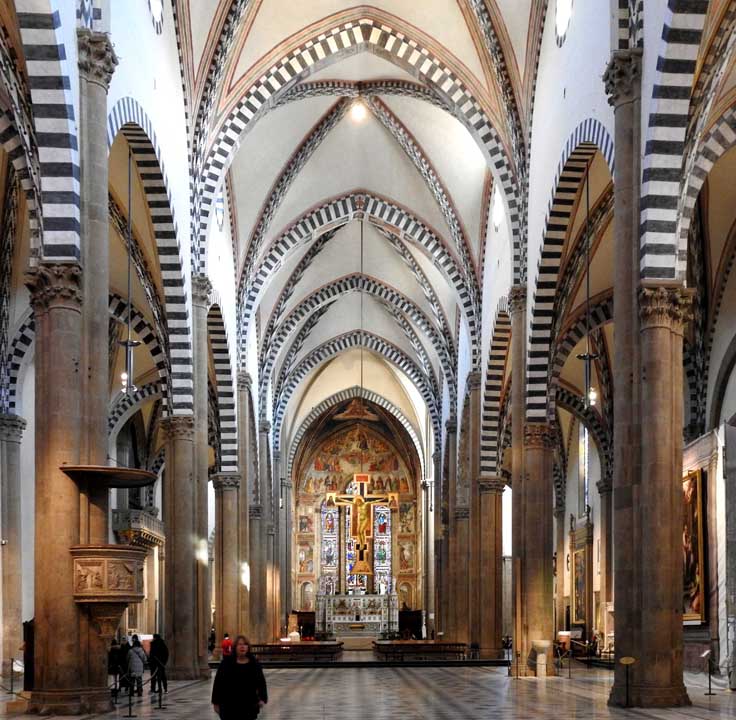 Nave and Tornabuoni Chapel This chapel serves as the chancel with the main altar and choir seating ... Frescoes by painted from 1485-1490 by Domenico Ghirlandaio whose apprentice was the young Michelangelo. The frescoes represent themes from the lives of the Virgin and John the Baptist. They contain portrayals of several members of important Florentine families. The vaults have roundels with paintings of the Evangelists. 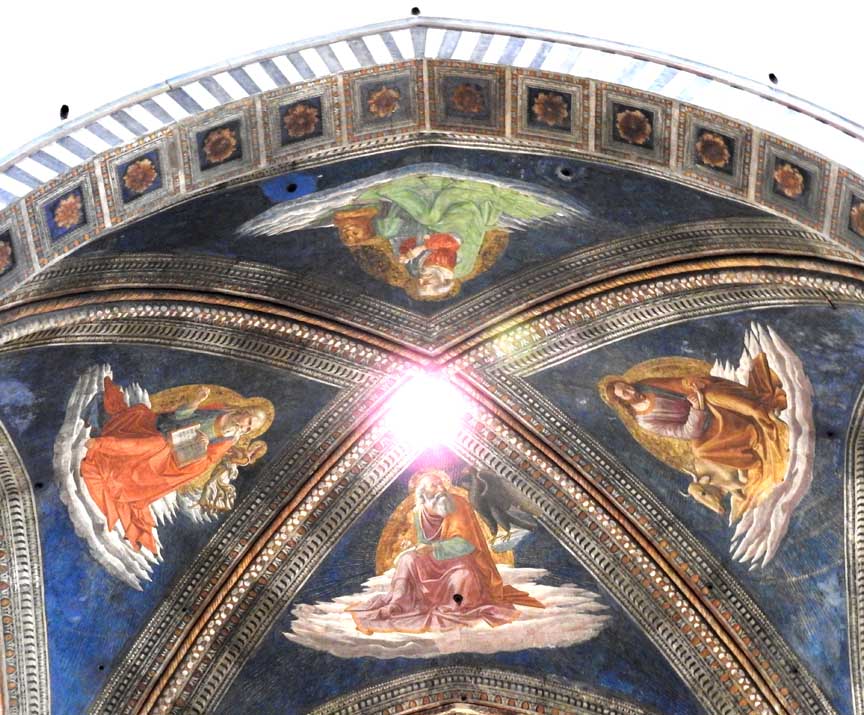 Chapel ceiling paintings depict the four evangelists ... Frescoes painted from 1485-1490 by Domenico Ghirlandaio  Heaven mural above stained glass windows ... Left murals depict scenes from the life of the Virgin Mary ... Right murals depict scenes from the life of St. John the Baptist whom the church is dedicated 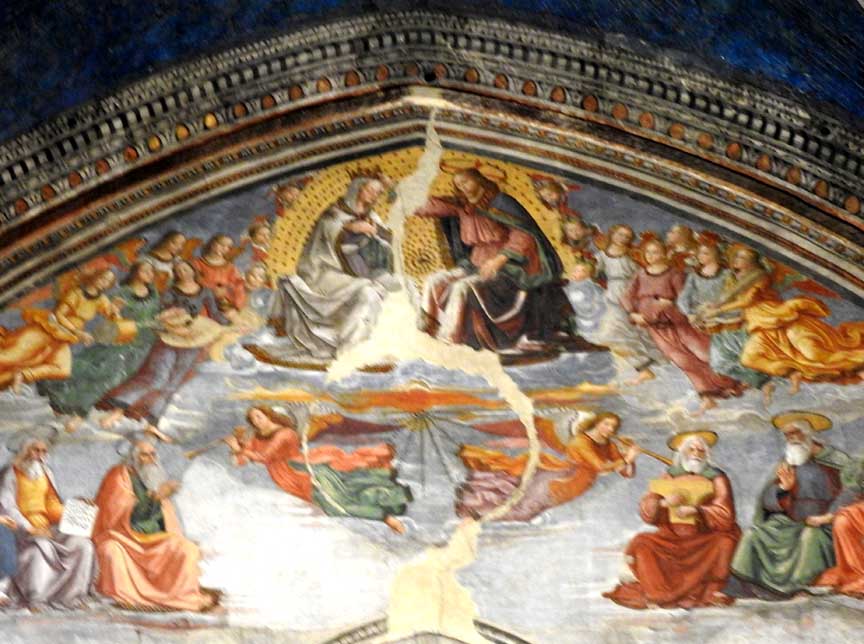 Coronation of Mary in Heaven Frescoes painted from 1485-1490 by Domenico Ghirlandaio 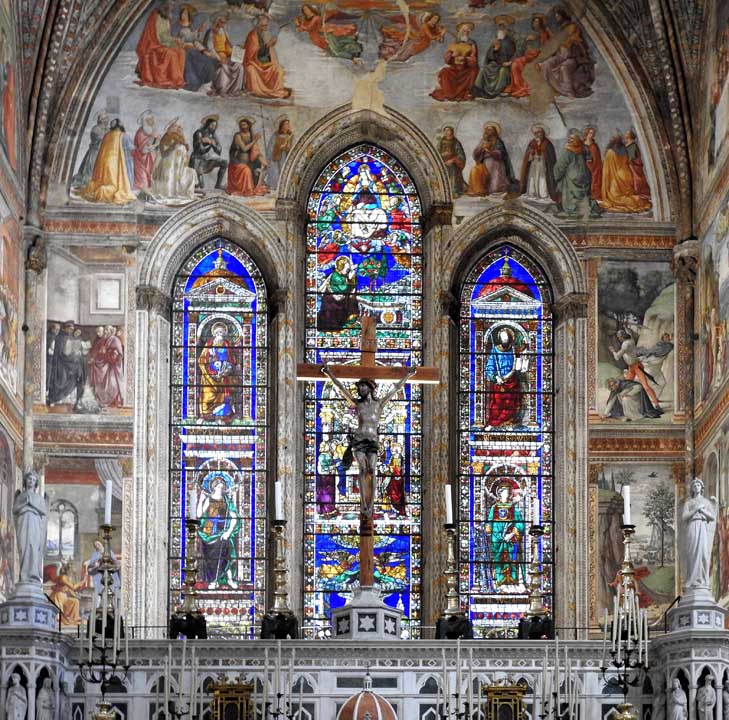 The stained-glass windows were made in 1492 by the Florentine artist Alessandro Agolanti, known also as Il Bidello, and were based on cartoons by Ghirlandaio. ... Crucifix, from the sixteenth century, is a work of Giambologna 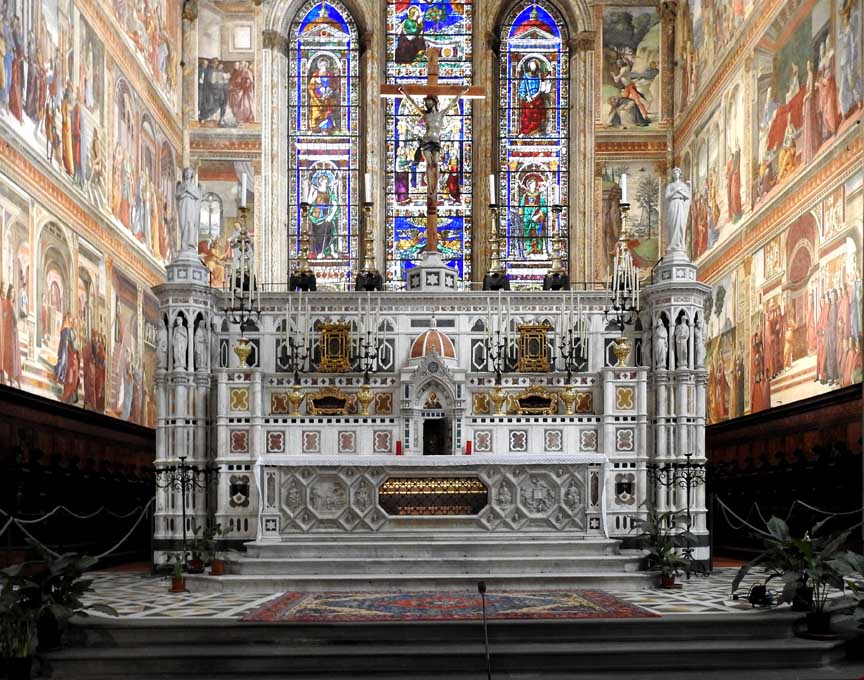 The wooden crucifix, from the sixteenth century, is a work of Giambologna. The choir stalls date from the fifteenth century, just as the three stained glass windows in the back wall which were created in 1491 after a design by Domenico Ghirlandaio. The same artist, who at the time was assisted by a fourteen-year-old Michelangelo Buonarroti, also created the magnificent frescoes on the walls. These frescoes, which date from 1485-1490, depict scenes from the life of Mary, to whom the church is dedicated, and from the life of St. John the Baptist, the patron saint of Florence. Ceiling paintings show the four evangelists. - A View on Cities 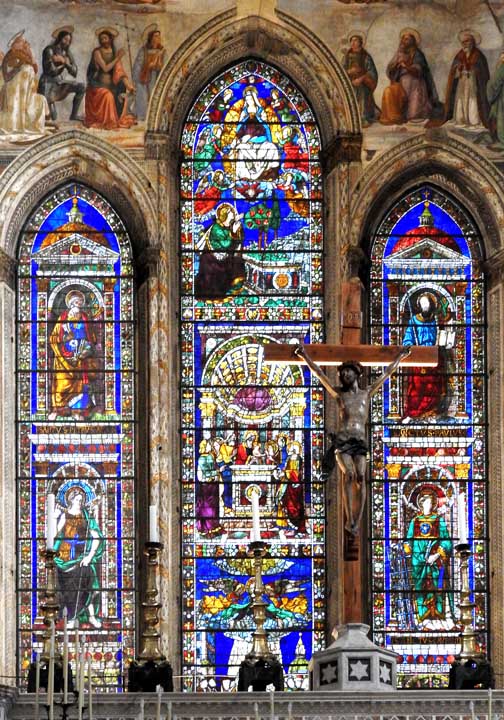 Stained glass panels detailed below: 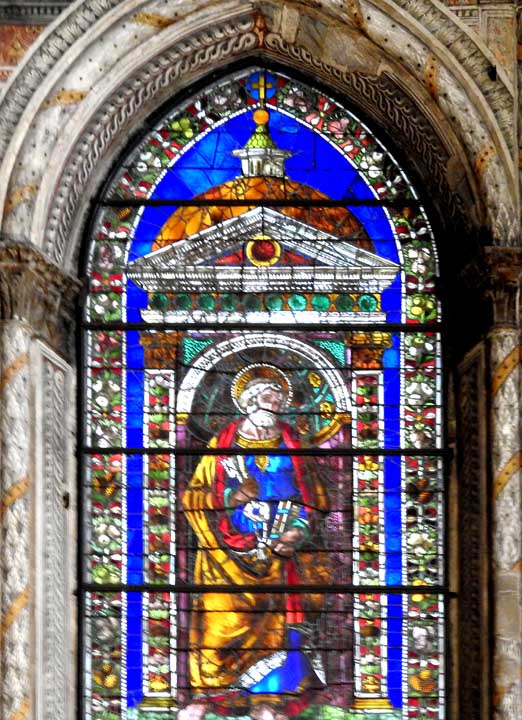 St. Peter holding the keys to heaven 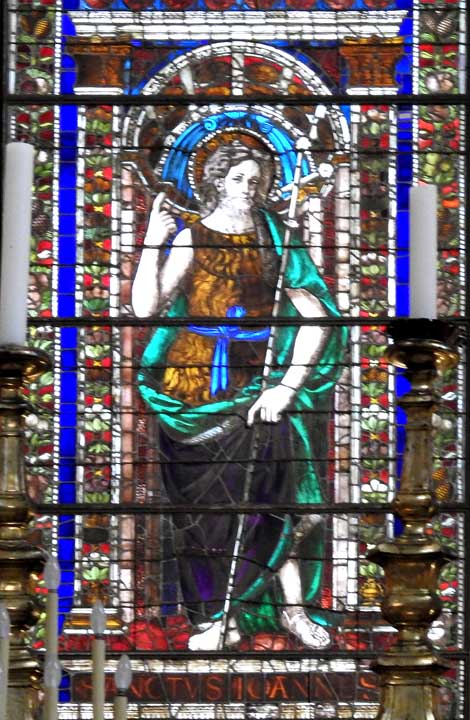 St. John the Baptist, patron saint of Florence  Madonna giving her girdle to Saint Thomas "The Girdle of Thomas, Virgin's
Girdle, Holy Belt, or Sacra Cintola in modern
Italian, is a Christian relic in the form of a "girdle" or knotted
textile cord used as a belt, that according to a medieval legend was
dropped by the Virgin Mary from the sky to Saint Thomas the Apostle at
or around the time of the Assumption of Mary to heaven. The supposed
original girdle is a relic belonging to Prato Cathedral in Tuscany in
Italy and its veneration has been regarded as especially helpful for
pregnant women. The story was frequently depicted in the art of
Florence and the whole of Tuscany, and the keeping and display of the
relic at Prato generated commissions for several important artists of
the early Italian Renaissance.
"In the story of the girdle, at the Assumption of Mary, where the other apostles were present, Thomas [Doubting Thomas, the apostle] once again missed the occasion (being on his way back from India), so the Virgin Mary, aware of Thomas' sceptical nature, appeared to him individually and dropped the girdle she was wearing down onto him, to give him a physical proof of what he had seen." - Wikipedia (online May 2020) 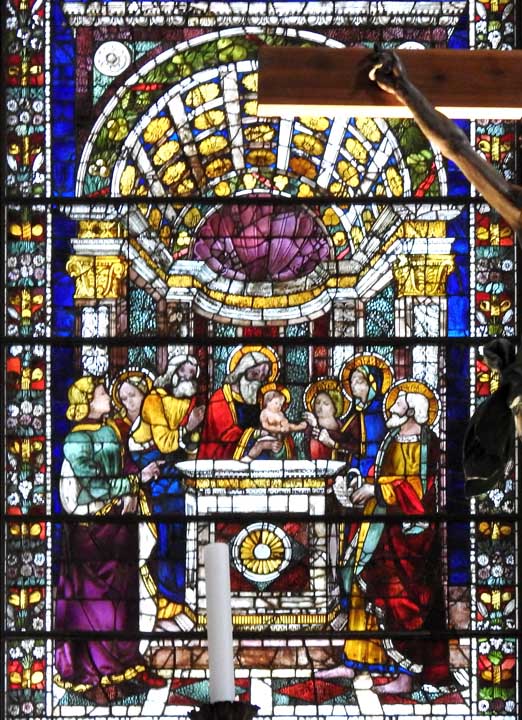 Presentation of Baby Jesus in the Temple 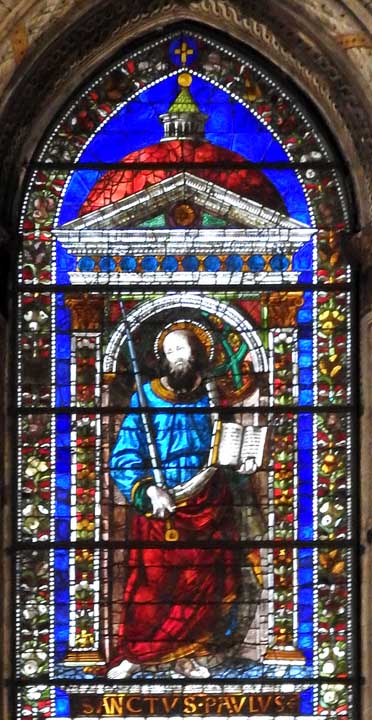 Top: St. Paul 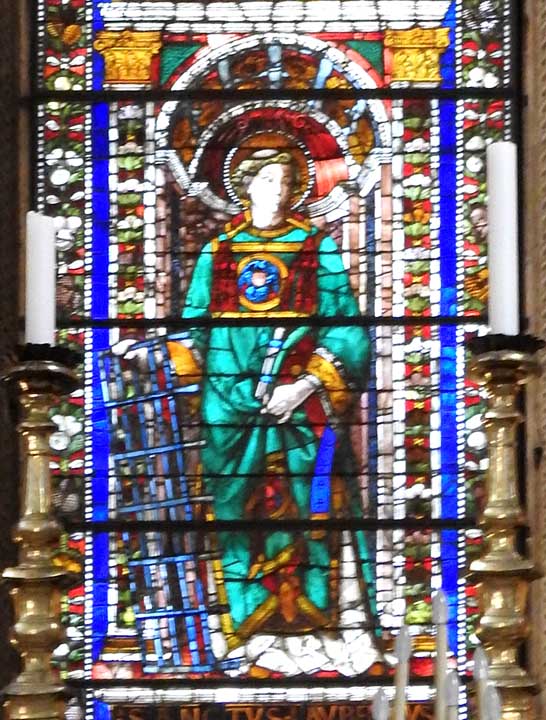 St. Lawrence depicted with the gridiron where he was martyred ... See also the mural by Girolamo Macchietti, Martyrdom of St. Lawrence, in the basilica's aisle 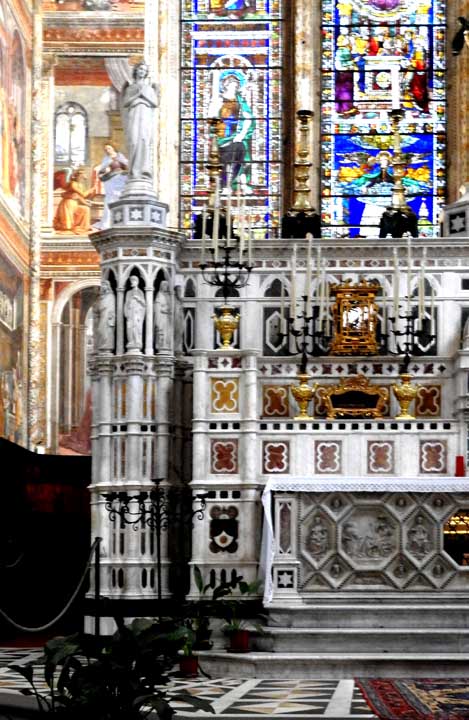 "The altar actually used to be smaller and placed in the center of the chapel but was enlarged in the 19th century with the large engraved marble altar we see today." - Visit Florence (online May 2020)  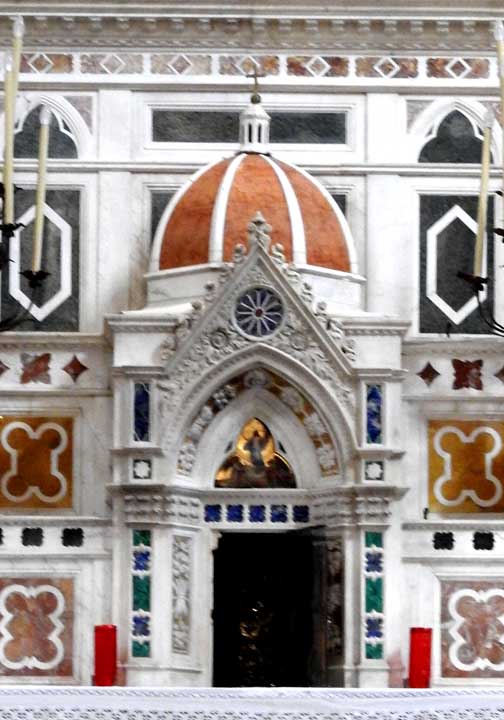 Tabernacle (ornamental locked box used for reserving the Communion hosts)  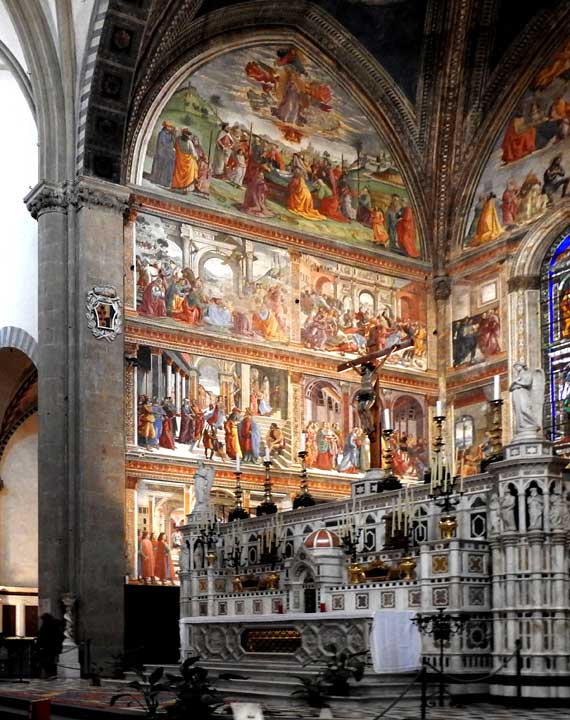 "The
Tornabuoni chapel is
dedicated to both the Virgin Mary, to whom the church is
dedicated
(scenes on the left), and to St. John the Baptist (scenes on the
right). The frescoes are by Domenico Ghirlandaio and his
workshop, in
which a very young Michelangelo was apprenticed. The three
young lads
giving their backs to the observer in the bottom right scene Mary
Visits Saint Elizabeth [illustration below] are said to be his
work. After restoration, the
vibrant colors are still stunning and Ghirlandaio's penchant for
including important people of the day in contemporary clothing make his
work to be actual "photographs" of his days." - Visit
Florence (online may 2020)
Frescoes
... Figures from the upper-class Florentine society of the
time people the scenes ... Four of the scenes
illustrated below:
 St. Joachim is Driven From the Temple Not in the Bible. Joachim and Anne were the parents of the Virgin Mary. Before Mary was conceived, Joachim was reproached at the Temple for his sterility. Joachim’s cult was introduced in the West in the 15th century. "The first episode represents
the
expulsion of Joachim, the father of Mary, from the Temple of Jerusalem.
A ceremony is taking place in which several figures are carrying lambs
for sacrifice. However, Joachim was banned from attending due to his
alleged sterility.
"Ghirlandaio set the scene in a sumptuous loggia of Greek cross plan, with a sequence of arches in the background and an octagonal altar in the middle, where the sacrificial fire is lit. The characters are illuminated from above, as if by the natural lighting from the real chapel windows. "Two groups of Florentine people, representing the populace, are shown to the sides of the scene. They wear contemporary fashionable clothes (for which the frescoes are a famous source), unlike the main biblical figures, who wear the usual "iconographic costume". On the left, two figures may be identified as Lorenzo Tornabuoni, son of Ghirlandaio's patron, and Piero di Lorenzo de' Medici, the former's friend. In the righthand group is a self-portrait of the artist with some of his relatives. The loggia in the background could be a representation of the Ospedale di San Paolo (St. Paul's Hospital), which was then under construction in the same square as Santa Maria Novella. The two buildings on the sides are examples of typical edifices of 15th-century Florence, characterized by rustication and an upper loggia." - Wikipedia (online May 2020)  The Birth of Mary "The second scene portrays the Nativity
of Mary, set in a luxurious room with inlaid wooden panelling
surmounted by a frieze
in bas-relief of
music-making putti
and a cornice
of winged cherubs. The room is divided by piers decorated in
relief. To the left, near the door at the top of the stairs is shown
symbolically an early incident of the story, the embrace of Anne and
Joachim, at the Golden Gate of Jerusalem.
"To the right, St. Anne, reclines in bed, while three young women prepare to bath the new-born Mary. The nurse who is pouring water into a basin is the only figure in the room to be moving rapidly. Her flowing robes and swirling scarf make her an iconic motif to be found in many paintings both by Ghirlandaio and other painters and sculptors of the period. A preparatory drawing of this woman has been preserved in the Cabinet of Prints and Drawings of the Uffizi. "Several well-dressed Florentine ladies have come on a congratulatory visit. The first in the procession of noblewoman, portrayed in profile, is Ludovica, daughter of Giovanni Tornabuoni. The rendering of the magnificent women's clothes is particularly notable. The scene is considered one of the best executed in the chapel. Unlike the previous scene, nearly all the portraits show a great care: they were probably executed by the master himself, while the less well executed are probably painted by his assistants. "Above the cabinets in the background is an inscription reading: "NATIVITAS TUA DEI GENITRIX VIRGO GAUDIUM ANNUNTIAVIT UNIVERSO MUNDO" ("Your birth, oh Virgin Mother, announced joy to the whole universe"), while in the intarsia decoration the artist put his signature: "BIGHORDI" (his true surname, Bigordi) and "GRILLANDAI" (the Florentine version of his nickname). "This scene, like the previous one, is realistically illuminated, with the frieze on the right in shadow. While the majority of scenes in the chapel have a completely symmetrical arrangement in their internal architecture and even the positioning of the figures, this picture is markedly asymmetrical, with a pier dividing it into two areas based on the golden mean. This asymmetrical structure links it to the scene of The Visitation in which a wall is placed to divide the picture space in the same manner. However the positioning of the figures, with St. Anne in bed and the group entering from the left is mirrored by The Birth of St John, although there the figures are placed in a much more conventional internal space." - Wikipedia (online May 2020) 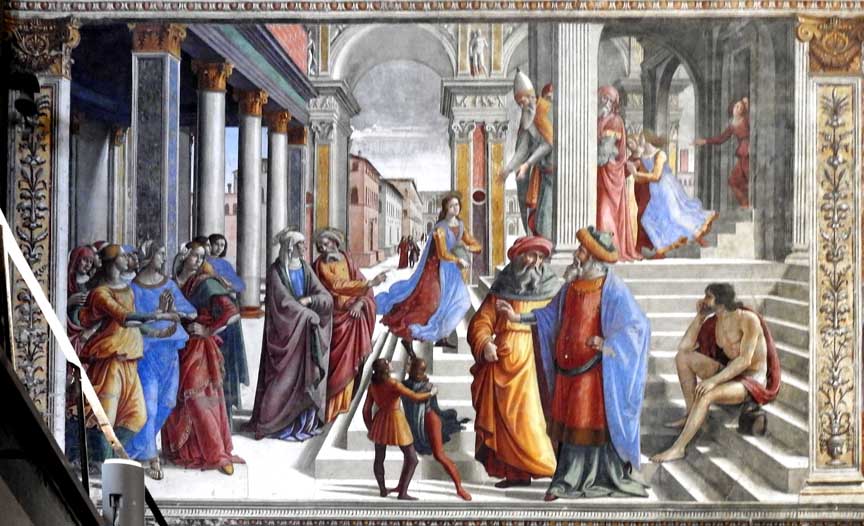 The Presentation of Mary at the Temple "The
Presentation is a complex composition, with numerous characters
placed on different levels. In the centre, the young Mary, holding a
book, is ascending the Temple's staircase towards the priest, but is
looking in the viewer's direction. Her awkward posture is perhaps
intended to suggest her young shyness, but the figure appears rather
awkward.
"The role and meaning of the other figures who crowd the classical architectures of the scene are still partly unclear. The female figures on the right, portrayed with notable attention to detail, are probably portraits of real contemporary women. Next to them are St. Anne and Joachim, distinguishable by aureolas [halos], who point at their daughter Mary. Two young women, painted by workshop collaborators, are rushing out from the Temple. "The two small figures in the centre foreground have not been identified. They could be children, but have adult features. It has been suggested that, being observed from below, they acquire a more youthful appearance, so their unusual rendering could be a technical trick by Ghirlandaio. The symbolic role of the nude man sitting on the steps, on the right, is unknown. Next to him are two old men." - Wikipedia (online May 2020)  The Wedding of Mary and Joseph "The
Marriage of the Virgin is set in beautiful Renaissance
architecture, while the composition of the scene is rather traditional.
In the centre is the temple priest, with the same features as in the Presentation.
He is sealing the marriage between Joseph and Mary. To the sides are
two processions, with men on the left and women on the right. Some of
the former, angry at having not been chosen to marry Mary, are shown
while breaking their sticks or raising their fists (a story originating
in apocryphal legends of the life of Mary). Joseph's club, which had
been chosen as the most vigorous, is barely visible over his shoulder.
Most of the portraits are summary in style, apart some very carefully
executed ones near the priest." - Wikipedia
(online May 2020)
|
